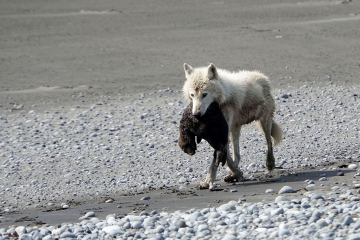690923_Otters and Wolves_360 px width.jpg

Sea otters are now the primary prey of wolves on Pleasant Island, Alaska. Credit: NPS photo/Kaitlyn Kunce.
Good news for one species isn’t necessarily good news for all. Consider the wildlife on Pleasant Island, off the coast of southeastern Alaska. Sea otters returned to the island a couple of decades ago. Gray wolves came along a decade later. The wolves ate most of the island’s deer, then started hunting the otters. That’s good for the wolves, but bad news for everyone else.
Fur hunters nearly wiped out otters in the region in the 18th and 19th centuries. But thanks to legal protections and conservation efforts, the population has rebounded. In fact, it’s about reached the maximum healthy number for both the otters and their habitat.
Gray wolves almost vanished, too, but they’ve also staged a comeback. Two of them apparently swam to Pleasant Island from the mainland in 2013, establishing a new pack.
Researchers began studying the wolves two years later. They watched the wolves in person, tracked them with GPS, and analyzed their poop to see what they’d been eating. In 2015, 75 percent of the wolves’ diet consisted of deer. By 2017, though, deer accounted for just seven percent. By then, sea otters accounted for more than half of their diet—the deer had all but vanished.
The researchers also saw that the wolves were actively hunting the otters—they developed tactics to surround the otters before they could escape to the ocean. So a success story for the sea otters might not stay that way—good news turned bad on a remote Alaskan island.

